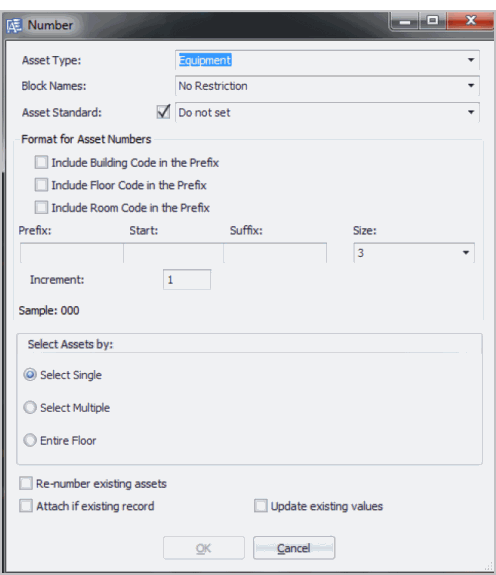Smart Client Extension for AutoCAD
Number Command
Command: AFM_NUMBER
How to access this command: Select Archibus/Asset/Number from the Ribbon, run the command from the command line, or choose the Number task from the Navigator in CAD.
Purpose: The Number command data numbers one or more drawing entities on the prototype layer, or renumbers one or more asset symbols on the asset layer. Data numbering is useful when you want to assign sequential primary keys to several items at one time.
Select a Navigator task for the drawing items you want to convert to an asset symbol. For example, select Set Rooms to set the current layer in the drawing to the asset layer holding items you want to number, issue the Number command to specify the numbering pattern, and then select, in the order that you want numbers to increment, each item to be numbered. When you are through numbering items, press the Enter key to exit the command.
Selecting Items to Number
When selecting items to number, you can only select items that are located on the current asset layer.
The command re-numbers existing asset symbols or numbers drawing entities:
- If the selected drawing entity is on the prototype layer, the command generates a primary key and a corresponding record in an asset table, and moves the entity from the prototype layer to the asset layer.
- If the selected asset symbol is on the asset layer, the command renumbers it according to the specified numbering scheme and updates the record.
Procedure: Running the Command
To run the Number command:
- Select Archibus / Asset / Number from the Ribbon.
The Number form appears.

- Enter the following information:
Asset Type Select the type of asset you are numbering, such as rooms or suites. The list shows asset types that have one or more occurrence in the current drawing. Block Name Select a block to restrict the numbering to that block. The list shows the block names that have one or more occurrences in the current drawing for the specified asset type, that is. the block is on the Prototype or Asset layer. - Set Asset Standards. To apply asset standards to the assets as the numbers are applied to the elements, select one of the options from the drop down list. The list of asset standards that are displayed depends on whether or not you select the Asset Standards check box:
- Checked: Displays only already used Asset Standards for the selected Revit Category. This is the default.
- Unchecked: Displays all possible Asset Standards from the database.
- Set the number formatting.
Select to include the building, floor, or room codes as prefixes for the number, by selecting their check boxes.
Prefix Assign a prefix to all numbers. If you specify a prefix of "RM-" and a start number of "0001", the first generated number will be "RM-0001", the second "RM-0002", and so forth. Start Enter the number at which you want to start numbering Suffix Assign a suffix to all numbers. If you specify a suffix of "a" and a start number of "RM-0001", the first generated number will be "RM-0001a", the second "RM-0002a", and so forth Size Enter a number to specify how many digits the generated number will have. For example, if you enter "1" in the Start field and "4" for this option, the first number will be "0001. Increment Enter the increment between numbers. If you set the increment as "4" and the start number is "0001", the second number will be "0005", the third "0009", and so forth. Notes:
- If the Room Code is checked, as the actual Room Code is not known until Numbering individual assets, the Sample will display <> as a placeholder for that value.
- If the selected Asset Type is 'Room', then the Room Code check box is disabled.
- The displayed Sample value, which is a concatenation of Building Code, Floor Code, Room Code, Prefix, Start, Suffix, and Size values, is color coded to indicate whether or not the length of the string is <= than the maximum number of characters allowed for the selected Asset Type.
- Black if the length is OK.
- Orange is displayed if the length is too long, and the Room Code is included as part of the sample. This is because the actual Room Code is not known before the numbering is processed, and the color coding is meant as a warning. When numbering under this condition, Asset Codes that are valid at the time of numbering will be processed; otherwise, the invalid ones are ignored.
- Red is displayed if the length is too long (and the Room Code check box is not selected). The OK button will be disabled as the Asset Codes are greater than the maximum length for the selected Asset Type.
-
Attach if Existing Record: Select this check box if you want to link the asset symbol to an existing record that is already identified by the generated number, but not linked to an asset symbol. With this option checked, the command automatically links the asset symbol to a record with the same primary key. To prevent damaging existing asset symbols, you cannot attach the selected entity to a record that is already linked to an asset symbol.
-
Update Existing Values: Select this check box if you want existing records to be updated with the values you enter. If you do not select this check box, if any existing records are selected, the existing values for these records are preserved.
- Click OK.
You are prompted to select a room boundary for each asset. A message informs you of the asset you are attaching to. For example, you are prompted to select a room boundary to attach Room '2-202'
- Select the room boundary.
- Press Enter to exist the command.